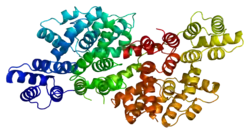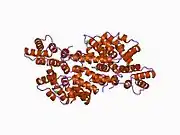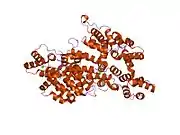Annexin A6 is a protein that in humans is encoded by the ANXA6 gene.[5]
Function
Annexin VI belongs to a family of calcium-dependent membrane and phospholipid binding proteins. Although their functions are still not clearly defined, several members of the annexin family have been implicated in membrane-related events along exocytotic and endocytotic pathways. The annexin VI gene is approximately 60 kbp long and contains 26 exons. It encodes a protein of about 68 kDa that consists of eight 68-amino acid repeats separated by linking sequences of variable lengths. It is highly similar to human annexins I and II sequences, each of which contain four such repeats. Exon 21 of annexin VI is alternatively spliced, giving rise to two isoforms that differ by a 6-amino acid insertion at the start of the seventh repeat. Annexin VI has been implicated in mediating the endosome aggregation and vesicle fusion in secreting epithelia during exocytosis.[6]
Interactions
ANXA6 has been shown to interact with RAS p21 protein activator 1.[7]
References
- 1 2 3 GRCh38: Ensembl release 89: ENSG00000197043 - Ensembl, May 2017
- 1 2 3 GRCm38: Ensembl release 89: ENSMUSG00000018340 - Ensembl, May 2017
- ↑ "Human PubMed Reference:". National Center for Biotechnology Information, U.S. National Library of Medicine.
- ↑ "Mouse PubMed Reference:". National Center for Biotechnology Information, U.S. National Library of Medicine.
- ↑ Crompton MR, Owens RJ, Totty NF, Moss SE, Waterfield MD, Crumpton MJ (Jan 1988). "Primary structure of the human, membrane-associated Ca2+-binding protein p68 a novel member of a protein family". The EMBO Journal. 7 (1): 21–7. doi:10.1002/j.1460-2075.1988.tb02779.x. PMC 454210. PMID 3258820.
- ↑ "Entrez Gene: ANXA6 annexin A6".
- ↑ Chow A, Gawler D (Oct 1999). "Mapping the site of interaction between annexin VI and the p120GAP C2 domain". FEBS Letters. 460 (1): 166–72. doi:10.1016/S0014-5793(99)01336-8. PMID 10571081. S2CID 42114086.
Further reading
- Moss SE, Jacob SM, Davies AA, Crumpton MJ (Nov 1992). "A growth-dependent post-translational modification of annexin VI". Biochimica et Biophysica Acta (BBA) - Protein Structure and Molecular Enzymology. 1160 (1): 120–6. doi:10.1016/0167-4838(92)90045-f. PMID 1420329.
- Barel M, Gauffre A, Lyamani F, Fiandino A, Hermann J, Frade R (Aug 1991). "Intracellular interaction of EBV/C3d receptor (CR2) with p68, a calcium-binding protein present in normal but not in transformed B lymphocytes". Journal of Immunology. 147 (4): 1286–91. doi:10.4049/jimmunol.147.4.1286. PMID 1831222. S2CID 22824326.
- Yoshizaki H, Mizoguchi T, Arai K, Shiratsuchi M, Shidara Y, Maki M (Jan 1990). "Structure and properties of calphobindin II, an anticoagulant protein from human placenta". Journal of Biochemistry. 107 (1): 43–50. doi:10.1093/oxfordjournals.jbchem.a123009. PMID 2139657.
- Iwasaki A, Suda M, Watanabe M, Nakao H, Hattori Y, Nagoya T, Saino Y, Shidara Y, Maki M (Jul 1989). "Structure and expression of cDNA for calphobindin II, a human placental coagulation inhibitor". Journal of Biochemistry. 106 (1): 43–9. doi:10.1093/oxfordjournals.jbchem.a122816. PMID 2528541.
- Davies AA, Moss SE, Crompton MR, Jones TA, Spurr NK, Sheer D, Kozak C, Crumpton MJ (Jun 1989). "The gene coding for the p68 calcium-binding protein is localised to bands q32-q34 of human chromosome 5, and to mouse chromosome 11". Human Genetics. 82 (3): 234–8. doi:10.1007/BF00291161. PMID 2731935. S2CID 31607748.
- Südhof TC, Slaughter CA, Leznicki I, Barjon P, Reynolds GA (Feb 1988). "Human 67-kDa calelectrin contains a duplication of four repeats found in 35-kDa lipocortins". Proceedings of the National Academy of Sciences of the United States of America. 85 (3): 664–8. Bibcode:1988PNAS...85..664S. doi:10.1073/pnas.85.3.664. PMC 279615. PMID 2963335.
- Warrington JA, Bengtsson U (Nov 1994). "High-resolution physical mapping of human 5q31-q33 using three methods: radiation hybrid mapping, interphase fluorescence in situ hybridization, and pulsed-field gel electrophoresis". Genomics. 24 (2): 395–8. doi:10.1006/geno.1994.1636. PMID 7698768.
- Barel M, Balbo M, Gauffre A, Frade R (Apr 1995). "Binding sites of the Epstein-Barr virus and C3d receptor (CR2, CD21) for its three intracellular ligands, the p53 anti-oncoprotein, the p68 calcium binding protein and the nuclear p120 ribonucleoprotein". Molecular Immunology. 32 (6): 389–97. doi:10.1016/0161-5890(95)00005-Y. PMID 7753047.
- Smith PD, Davies A, Crumpton MJ, Moss SE (Mar 1994). "Structure of the human annexin VI gene". Proceedings of the National Academy of Sciences of the United States of America. 91 (7): 2713–7. Bibcode:1994PNAS...91.2713S. doi:10.1073/pnas.91.7.2713. PMC 43440. PMID 8146179.
- Benz J, Bergner A, Hofmann A, Demange P, Göttig P, Liemann S, Huber R, Voges D (Aug 1996). "The structure of recombinant human annexin VI in crystals and membrane-bound". Journal of Molecular Biology. 260 (5): 638–43. doi:10.1006/jmbi.1996.0426. PMID 8709144.
- Davis AJ, Butt JT, Walker JH, Moss SE, Gawler DJ (Oct 1996). "The Ca2+-dependent lipid binding domain of P120GAP mediates protein-protein interactions with Ca2+-dependent membrane-binding proteins. Evidence for a direct interaction between annexin VI and P120GAP". The Journal of Biological Chemistry. 271 (40): 24333–6. doi:10.1074/jbc.271.40.24333. PMID 8798684.
- Barwise JL, Walker JH (Jan 1996). "Annexins II, IV, V and VI relocate in response to rises in intracellular calcium in human foreskin fibroblasts". Journal of Cell Science. 109 (1): 247–55. doi:10.1242/jcs.109.1.247. PMID 8834809.
- Kester HA, van der Leede BM, van der Saag PT, van der Burg B (Jun 1997). "Novel progesterone target genes identified by an improved differential display technique suggest that progestin-induced growth inhibition of breast cancer cells coincides with enhancement of differentiation". The Journal of Biological Chemistry. 272 (26): 16637–43. doi:10.1074/jbc.272.26.16637. PMID 9195978.
- Song G, Campos B, Wagoner LE, Dedman JR, Walsh RA (Mar 1998). "Altered cardiac annexin mRNA and protein levels in the left ventricle of patients with end-stage heart failure". Journal of Molecular and Cellular Cardiology. 30 (3): 443–51. doi:10.1006/jmcc.1997.0608. PMID 9515022.
- Garbuglia M, Verzini M, Donato R (Sep 1998). "Annexin VI binds S100A1 and S100B and blocks the ability of S100A1 and S100B to inhibit desmin and GFAP assemblies into intermediate filaments". Cell Calcium. 24 (3): 177–91. doi:10.1016/S0143-4160(98)90127-0. PMID 9883272.
- Chow A, Gawler D (Oct 1999). "Mapping the site of interaction between annexin VI and the p120GAP C2 domain". FEBS Letters. 460 (1): 166–72. doi:10.1016/S0014-5793(99)01336-8. PMID 10571081. S2CID 42114086.
- Dieudonné SC, Kerr JM, Xu T, Sommer B, DeRubeis AR, Kuznetsov SA, Kim IS, Gehron Robey P, Young MF (Dec 1999). "Differential display of human marrow stromal cells reveals unique mRNA expression patterns in response to dexamethasone". Journal of Cellular Biochemistry. 76 (2): 231–43. doi:10.1002/(SICI)1097-4644(20000201)76:2<231::AID-JCB7>3.0.CO;2-X. PMID 10618640. S2CID 29888940.
- Pfander D, Swoboda B, Kirsch T (Nov 2001). "Expression of early and late differentiation markers (proliferating cell nuclear antigen, syndecan-3, annexin VI, and alkaline phosphatase) by human osteoarthritic chondrocytes". The American Journal of Pathology. 159 (5): 1777–83. doi:10.1016/S0002-9440(10)63024-6. PMC 1867060. PMID 11696438.
- Takagi H, Asano Y, Yamakawa N, Matsumoto I, Kimata K (Aug 2002). "Annexin 6 is a putative cell surface receptor for chondroitin sulfate chains". Journal of Cell Science. 115 (Pt 16): 3309–18. doi:10.1242/jcs.115.16.3309. PMID 12140262.
External links
- Human ANXA6 genome location and ANXA6 gene details page in the UCSC Genome Browser.







